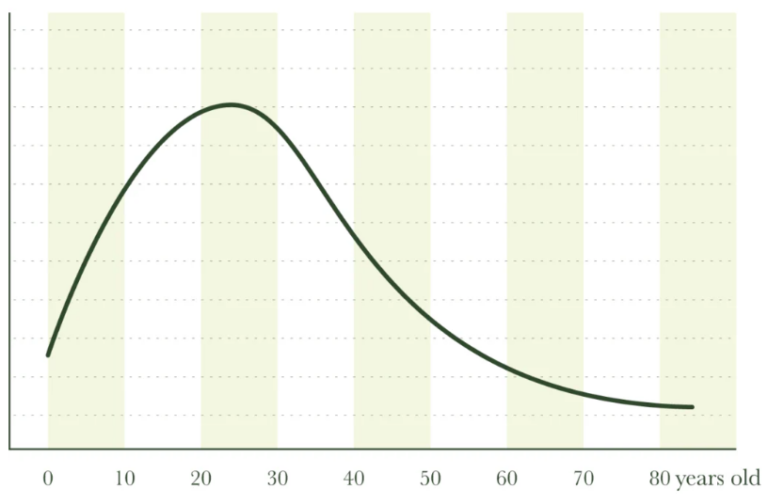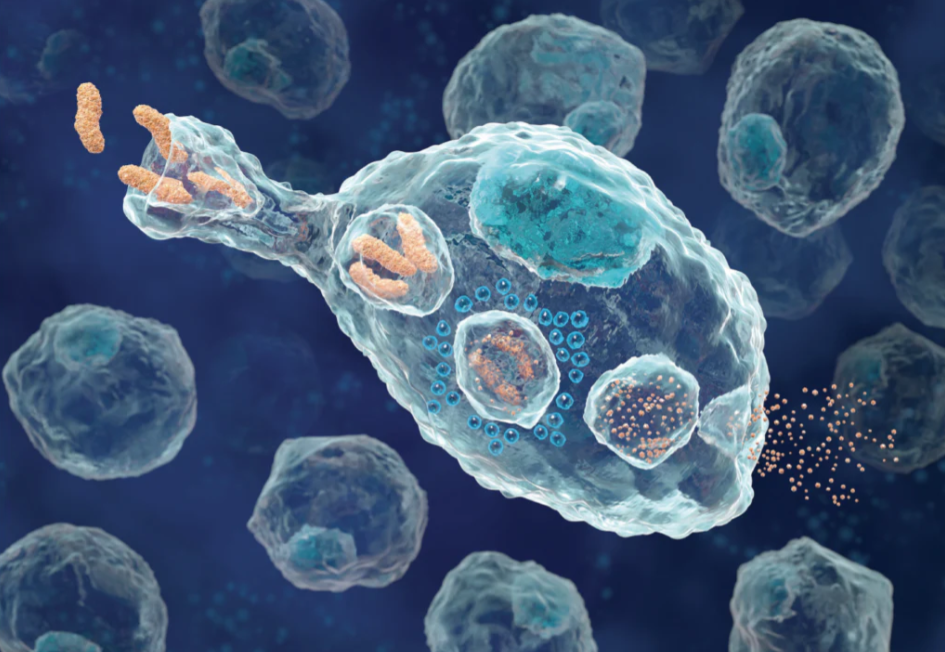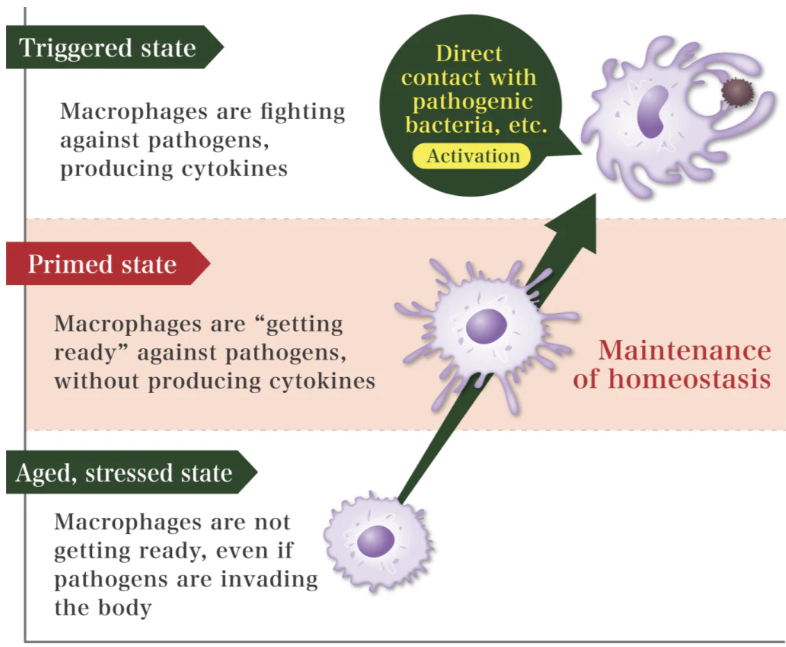Your one-stop destination for Dietary MAF activate Macrophage.
Dietary MAF has been in development for more than 10 years. It is a macrophage activating food.
Macrophages are a type of white blood cell or leukocyte. Macrophages are activated by MAF. Macrophages are present in the body of all living beings. Every day we protect our bodies with “immunity”.
The immune system is a system to keep your body healthy. It protects the body from bacteria and viruses and eliminates cancer cells. However, biological function and physical performance begin to peak from the age of 20, waning by half in the 40s.
As the immune system weakens with age, it becomes easier to get sick.
So it is important to keep boosting your immune system and keep it young so that you can lead a good long life.

Suddenly, it becomes easier to catch a cold but more difficult to get rid of it. Before, you could recover from your tiredness after a good night’s sleep. But now, you are still tired the next day. This may indicate a weakened immunity. When immunity weakens, it may cause the following symptoms.
It becomes easier to catch a cold or the flu
When a person’s immunity weakens, the ability of immune cells to fend off foreign substances such as bacteria and viruses decreases, and he/she becomes more susceptible to diseases, such as a cold or the flu.
It is easy to get a mouth ulcer
When a person’s immunity is weakened by stress or tiredness, it is easier to get a mouth ulcer.
Wounds won’t heal as well as before
When a person’s immunity weakens, wounds heal slower. Immune cells are also involved in healing wounds.
It is easy to get tired but difficult to recover
When a person’s immunity is weak, it takes longer to recover from mental and physical exhaustion and feelings of tiredness remain. Immunity is also affected by stress and tiredness.
Allergy symptoms
When a person’s immune system is not functioning properly, his/her immunity becomes over-sensitive. While it should “protect the body against foreign substances such as bacteria and viruses”, the body even reacts to substances that are not foreign bodies, resulting in allergic symptoms.
Cancer risk
It is said that thousands of cancer cells are born every day even in a healthy person. When a person’s immunity functions properly, the immune cells detect the cancer cells and prevent their proliferation. However, if the immunity weakens, the function of the immune cells also decreases and the cells may be unable to suppress the proliferation of cancer cells.
Immunity does not just “protect the body from foreign substances such as bacteria and viruses.” Immune cells are also actively involved in restoring a person’s skin to its original condition by closing a wound at the time of injury, and in curing a cold or the flu.
Immunity is involved in various activities, such as repairing injured cells in the body, promoting metabolism, as well as preventing body function decline and cellular tissue aging. For the immune system, white blood cells are composed of various immune cells that carry out most activities.
Macrophages are a type of immune cell. These are a type of white blood cells. They exist in the body of all living things and play an important role in keeping our bodies healthy.
Macrophages are ameboid cells that play a central role among immune cells. They ingest and break down bacteria and viruses that have invaded the body, as well as foreign substances such as cancer cells.
When bacteria and foreign substances are detected in the body, macrophages, which are phagocytic cells, begin eating those substances and at the same time, send signals to other immune cells alerting them about the existence of foreign substances.
Other immune cells that have received the information also begin to respond to the foreign substances. Pus from a wound and nasal discharge occurring when the body tries to overcome a cold, etc. are the result of immune cell activity.

Macrophages are present throughout the body. They patrol the area, looking for things that are not needed for a healthy life. When unnecessary substances such as “cancer cells” are identified, or when “viruses” and “bacteria” invading the body are detected, the macrophages capture them inside their cells and perform a series of tasks such as “attack”, “decomposition” and “digestion” to prevent infection.
Macrophages are one type of immune cell and there are many other immune cells as well. Macrophages demonstrate effective versatility for various diseases. However, sometimes other immune cells may be more effective. In such cases, macrophages function as “commander in chief,” instructing other immune cells to fight infection.
Immunity has the power to calm the inflammation of a wound and provide healing in the event of injury. This healing power also works to keep our skin and hair beautiful and youthful. This is an interesting function for people concerned about beauty.

1. The condition where it is not possible to immediately fight, even when pathogens have invaded the body.
2. The condition where the body can shift into a stance that is ready to fight as soon as pathogens invade the body.
3. A defensive stance where pathogens are confronted and tasks such as “attack”, “decomposition” and “digestion”.
Condition 2 is called the “priming state.” Maintaining good health and an abundance of macrophages at this activation stage is desirable.
One of these substances is called MAF (Macrophage Activating Factor).
MAF activates macrophages and prevents infection by carrying out a series of tasks, including “attack”, “decomposition” and “digestion”, against viruses and bacteria that invade the body, and cancer cells.
*This series of tasks may cause an inflammatory response, leading to fever, etc.
Up to this point, what happens when immunity is weakened and what activities are performed by the immunity system have been explained. Within this, macrophages have been described as playing a very important role, and there is a substance that activates macrophages in particular.
Based on our collective study achievement, MAF series products can be expected to be effective in activating macrophages. With regards to macrophage-activating substances, there are many ways and various things that exist in this world.
One of the features of the MAF series is that it leads the body to prepare for a fight without causing an inflammatory reaction when activating macrophages.
We strive to develop products that will help to support the immune system without any side effects.
We are thinking about how to help you be healthy every day.
GcMAF stands for ‘Gc protein-derived Macro-phage Activating Factor.’ At Saisei
Mirai, are proud to work with six Japanese universities to advance our research in the field of health and medicine.
In Japan, we proudly offer five distinct types of GcMAF, each with its unique purpose and potential: Old GcMAF, Serum GcMAF, Autologous GcMAF, Exciting Dietary MAF, and Recombinant MAF.
Old GcMAF, which was the first generation GcMAF, utilized a vitamin D3 affinity column repeatedly in a shared environment. This method carried the risk of cross-contamination and is no longer available.
We have shifted our focus to newer generations of GcMAF which includes Serum GcMAF, Autologous GcMAF, Dietary MAF, and Recombinant MAF.
We offer Dietary MAF products at Saisei Serbia.
What happens when immunity is weakened and what activities are performed by the immunity system have been explained. Within this, macrophages have been described as playing a very important role, and there is a substance that activates macrophages in particular.
With regards to macrophage-activating substances, there are many ways and various things that exist in this world. One of the features of the MAF series is that it leads the body to prepare for a fight without causing an inflammatory reaction when activating macrophages.
We strive to develop products that will help to support the immune system without any side effects.
We are thinking about how to help you be healthy every day.
| Main location | Types of phagocytes |
|---|---|
| Gut and intestinal Peyer’s patches * | macrophages |
| Lungs * | macrophages, monocytes, mast cells, dendritic cells |
| Blood | neutrophils, monocytes |
| Bone marrow | macrophages, monocytes, sinusoidal cells, lining cells |
| Connective tissue | macrophages, monocytes, dendritic cells, histiocytes |
| Lymphoid tissue | macrophages, monocytes, dendritic cells |
| Spleen | macrophages, monocytes, sinusoidal cells |
| Thymus | macrophages, monocytes |
* These locations offer the best sites for GcMAF administration. The skin by subcutaneous (SC) or intramuscular (IM) injection, the gut by oral administration, and the lungs by inhalation using a nebulizer (such as Omron NE-U22V Portable Nebulizer).
